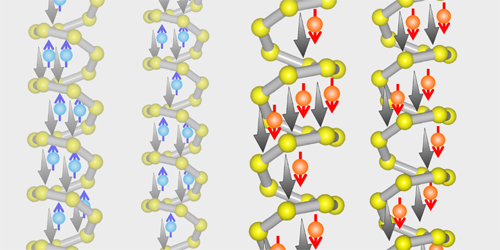Long-Range Spin Currents with Chiral Crystals
The spin-polarized currents used in spintronics are typically generated in ferromagnetic materials or materials with strong spin-orbit interaction. Spin-polarized electron currents can also be produced by certain materials whose structures have a “handedness”—an effect known as chirality-induced spin selectivity (CISS). Now, a team has shown that two chiral crystals, niobium silicide ( NbSi2) and tantalum silicide ( TaSi2), can produce and transport spin-polarized currents over distances exceeding 10 micrometers ( 𝜇m)—a record for this class of materials [1].
In 2020, Yoshihiko Togawa, of Osaka Prefecture University, Japan, and colleagues demonstrated CISS in a chiral crystal by showing that a charge current injected into the crystal would become spin polarized and would maintain that polarization over a distance of 1 µm. Such a distance was surprising, because it was greater than the length over which spins diffuse (about 100 nm or less), but the researchers argued that localized electron spins could “protect” the spins of the itinerant electrons. In the new work, Togawa’s team investigated NbSi2and TaSi2, which do not contain such localized spins. Thus, the team expected spin currents to survive over shorter distances but surprisingly found spin polarization persisting up to 10 𝜇m. This distance is still shorter than that seen in graphene or silicon, but chiral crystals have the advantage of acting both as spin polarizers and spin conductors—which could allow simpler designs for spintronic devices.
The researchers say that the precise mechanism behind this long-range CISS effect is still mysterious. However, they rule out that the enhancement is due to conventional spin-orbit interaction, since NbSi2, with a weaker spin-orbit interaction than TaSi2, exhibited the strongest CISS.
–Marric Stephens
Marric Stephens is a Corresponding Editor for Physics Magazine based in Bristol, UK.
References
- K. Shiota et al., “Chirality-induced spin polarization over macroscopic distances in chiral disilicide crystals,” Phys. Rev. Lett. 127, 126602 (2021).




